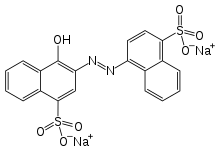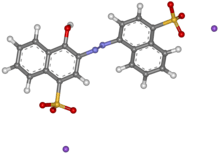Azorubine
Azorubine is an azo dye consisting of two naphthalene subunits.[1] It is a red solid. It is mainly used in foods that are heat-treated after fermentation. It has E number E122.[2]
 | |
 | |
| Names | |
|---|---|
| IUPAC name
disodium 4-hydroxy-2-[(E)-(4-sulfonato-1-naphthyl)diazenyl]naphthalene-1-sulfonate | |
| Other names
carmoisine, Food Red 3, Azorubin S, Brillantcarmoisin O, Acid Red 14, or C.I. 14720 | |
| Identifiers | |
3D model (JSmol) |
|
| ChEMBL | |
| ChemSpider | |
| ECHA InfoCard | 100.020.598 |
| EC Number |
|
| E number | E122 (colours) |
| KEGG | |
PubChem CID |
|
| UNII | |
CompTox Dashboard (EPA) |
|
| |
| |
| Properties | |
| C20H12N2Na2O7S2 | |
| Molar mass | 502.44 |
| Appearance | red powder |
| Melting point | >300 °C (572 °F) |
| Soluble (120g/l) | |
Except where otherwise noted, data are given for materials in their standard state (at 25 °C [77 °F], 100 kPa). | |
| Infobox references | |
Uses
In the US, this color was listed in 1939 as FD&C Red No. 10 for use in externally applied drugs and cosmetics. It was delisted in 1963 because no party was interested in supporting the studies needed to establish safety. It was not used in food in the US.[3][4]
In the EU, azorubine is known as E number E122, and is authorized for use in certain foods and beverages, such as cheeses, dried fruit, and some alcoholic beverages,[5] and is permitted for use as an excipient in medications.[6]:4[7]:16
There are no provisions for azorubine in the Codex Alimentarius.[8]
Safety
Azorubine has shown no evidence of mutagenic or carcinogenic properties and an acceptable daily intake (ADI) of 0–4 mg/kg was established in 1983 by the WHO.[9]:19 In rare instances, it may cause skin and respiratory allergic reactions even to FDA approved dosages.
No evidence supports broad claims that food coloring causes food intolerance and ADHD-like behavior in children.[10]:452 It is possible that certain food coloring may act as a trigger in those who are genetically predisposed, but the evidence is weak.[3][11]
References
- Klaus Hunger; Peter Mischke; Wolfgang Rieper; et al. (2005). "Azo Dyes". Ullmann's Encyclopedia of Industrial Chemistry. Weinheim: Wiley-VCH. doi:10.1002/14356007.a03_245.
- Pubchem entry
- FDA. Background Document for the Food Advisory Committee: Certified Color Additives in Food and Possible Association with Attention Deficit Hyperactivity Disorder in Children: March 30-31, 2011
- FDA. 9 November 2008. Food and Drug Administration, Compliance Program Guidance Manual, Chapter 03 - Foodborne Biological Hazards p37
- Azorubine entry in EU Food Additive Database Archived 11 December 2014 at the Wayback Machine Accessed 6 December 2014
- EU. 19 June 2007 Guideline on Excipients in the Dossier for Application for Marketing Authorisation of a Medicinal Product
- Directive 94/36/EC - European Commission
- Azorubine (Carmoisine) (122) in the GSFA Online Database Accessed 6 December 2014
- WHO, 1983. Evaluation of certain food additives and contaminants. Linked from WHO listing here
- Tomaska LD and Brooke-Taylor, S. Food Additives - General pp 449-454 in Encyclopedia of Food Safety, Vol 2: Hazards and Diseases. Eds, Motarjemi Y et al. Academic Press, 2013. ISBN 9780123786135
- Millichap JG; Yee MM (February 2012). "The diet factor in attention-deficit/hyperactivity disorder". Pediatrics. 129 (2): 330–337. doi:10.1542/peds.2011-2199. PMID 22232312.